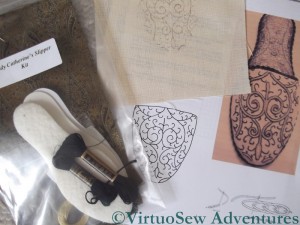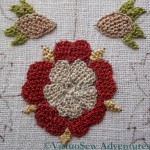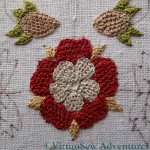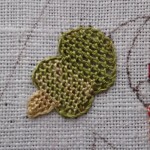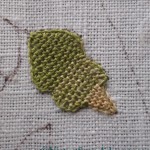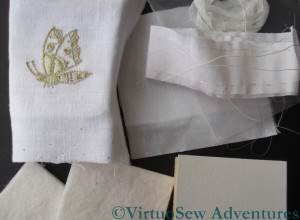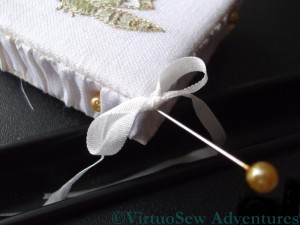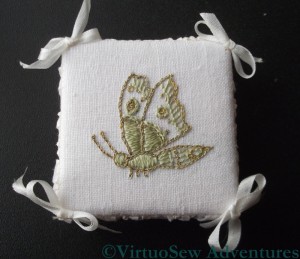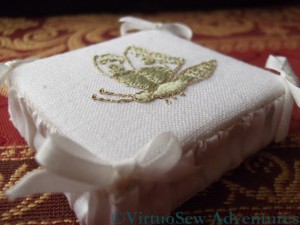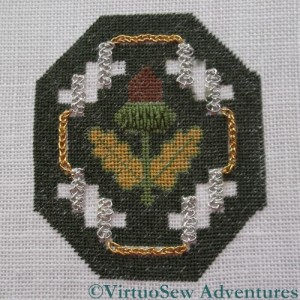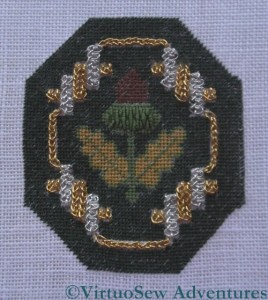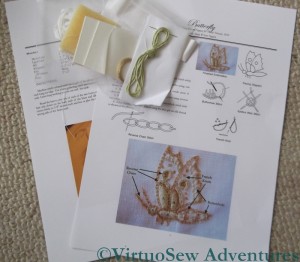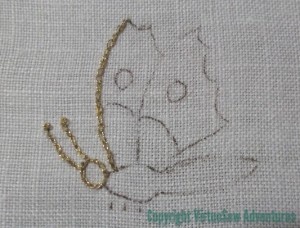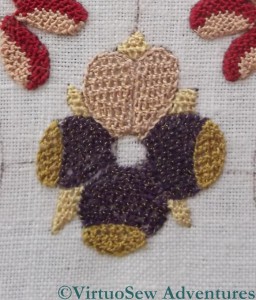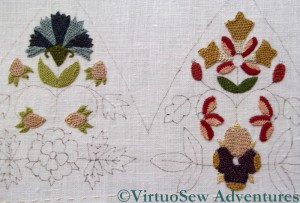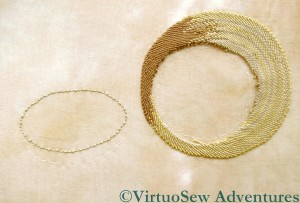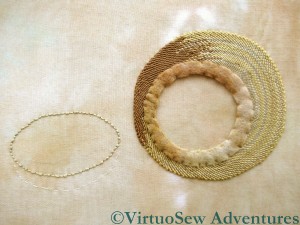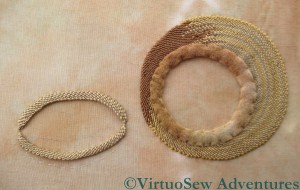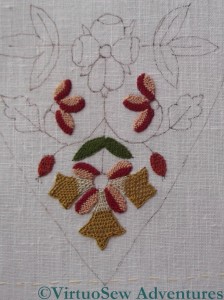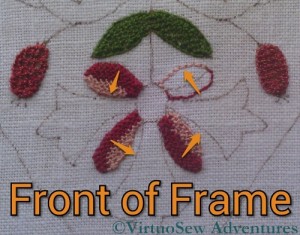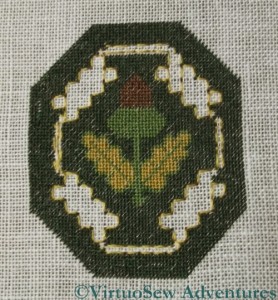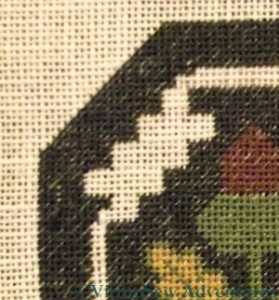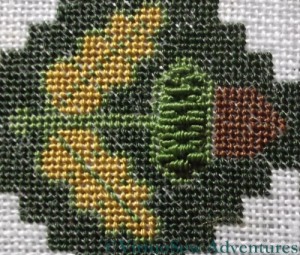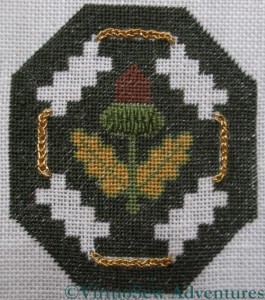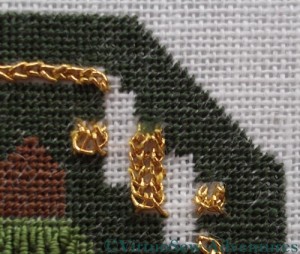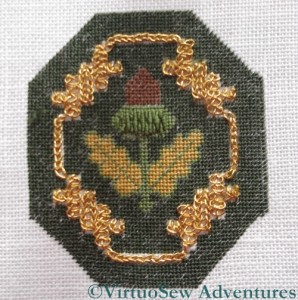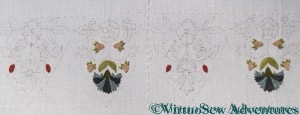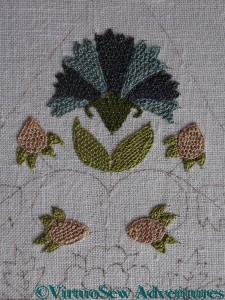Tag: Thistle Threads
Needlework Nibble – Lady Catherine’s Slipper
As though I haven’t enough to do, I have decided to do another of the Needlework Nibbles from Thistle Threads.
This one has gold curlicues edged in black and the background and lining are of black and gold silk brocade. I hesitated before deciding to take it on – black is a colour I’m not fond of – but since the gold was there to lift it, and since the various challenges of finishing the Nibbles are very good for me, I went ahead.
In the instructions, Tricia suggests using brown Micron pen for the main curlicues and black for the ornamental curls. That’s a great idea, but as brown is all I have (from the Glittering Nightcap kit) and my local artists’ suppliers don’t know about Micron I shall simply have to stay alert, especially as the lines have turned out rather faint.
The embroidery in this case seems fairly simple – the golden curlicues are worked in Heavy Chain Stitch, one of my favourites, and the black silk will be worked in Stem Stitch and Split Stitch.
As usual, therefore, the challenge will be in the making up. It will probably take me a week or so, once I’ve finished the embroidery, to gather my courage to tackle the finishing!
Update on Month Four of Glittering Gentleman’s Nightcap
My last post about the Glittering Gentleman’s Nightcap was in September, but I’m afraid it has not made much progress over the winter. This is because I only work on it when I have good natural light, and that means sitting in a bay window, which can be very cold indeed!
I managed to get one of the Tudor Roses done and then there was a long, chilly hiatus. Each petal is worked in Gilt Sylke Twist, outlined in reverse chain stitch and filled in with detached buttonhole with return. I think that is the same as “corded Brussels Stitch” in needle-lace, or if it is not, I have yet to work out the difference. The sepals are worked, again in detached buttonhole with return, using straw coloured silk.
As I mentioned in my previous post, Month Four consisted of the Tudor Roses and a plethora of leaves in a variety of combinations of colours. It was not uncommon for embroiderers of the period to blend colours in the needle, and Tricia suggested that we might choose to do the same. This is not quite as straightforward as one might hope, since of course the Soie Perlee is not intended to be plied and recombined, unlike the stranded cotton I used when I did something similar with Tracy Franklin in Durham.
It produces an interesting effect, and it does allow for a smoother colour change than using the threads in their normal state. What interested me, however, was that without being aware of changing my technique in any way, the coverage of the second leaf was markedly denser than that of the first.
Each leaf took about three-quarters of an hour to work, which tells me that I’ve some considerable time to go before I can get on to the goldwork or turn over to work the brim – there are about 28 more leaves to work!
The Butterfly Pinpad Finished
At long last I have finished the embroidery on the Butterfly Pinpad. The embroidery was simple enough – chain stitch, French knots, and satin stitch, worked either with a fine metal thread or pale green silk thread but the fine stitches gave me aching arms during the tennis elbow episode, so everything took longer than I would expect. Then of course I had to get started on finishing it. The reason it took me so long to wind myself up to it was – as some of you may have guessed – that glue was involved!
In fact, on this occasion, I cheated – if you can call it cheating when an embroideress uses her needle and thread! I chose to lace the butterfly itself, and the silk backing, onto their card supports, rather than attaching them with glue.
I found the ruched edging almost impossible to keep straight and even – perhaps I simply didn’t make the gathering threads quite even enough. Even squiffy, though, it looks quite luxuriant!
The bows were quite hair-raising to do, as well – tiny, made of very fine silk ribbon, and a little inclined to flop. I tied my fingers in knots, several times, as I made and attached the four of them!
Now that it’s finished, I’m pretty pleased with it, all the same, although I can’t imagine I’ll ever be able to bring myself to stick pins in it…
Dealing with the Golden Acorn
You last saw the Golden Acorn in July, when I was thoroughly fed up with it.
Since I’d got so engrossed in stitching that I’d neglected to pay attention to the details and had to unpick the lot, when I came to re-stitch I decided to put in the braid stitch in silver first.
I found the silver to be a more temperamental thread than the gold, although structurally it was exactly the same. However, these threads are all made more or less by hand, and must be hugely susceptible to temperature and humidity.
I know from my textile technology studies that natural fibres – such as cotton, wool, and silk – are susceptible to environmental conditions, because the basis for the success of the Lancashire cotton industry was due in no small part to the fact that ideal conditions for growing cotton are far from ideal for turning the cotton into cloth. In fact, nowadays, textile factories are built with climate control, because the speed of modern production demands that all possible variables be thoroughly ironed out.
In the same way, if you visit a woollen mill, you will see piles of wool at various stages of production, just sitting there. If you are a time-and-motion person you’ll get very uptight about this, and talk about “Just In Time” manufacturing – only to be told, in no uncertain terms, that if you want to pay for all the failed batches that will result from not allowing the wool to relax (technical term – yes, honestly) between processes, you’re welcome, but the manager won’t let it out of the factory with their name on it.
The silver and gold threads we are using have natural fibre cores, so sensitivity to climate is only to be expected!
I found both of the two main stitches in the strapwork, Ceylon stitch and Braid Stitch, rather troublesome in metal thread, although Braid Stitch in pearl cotton is one of my favourites. There’s no denying that they produce a rich and exotic effect once they are in place, though!
I became slightly fed up with tent stitch – there was such a lot of it! – while I was working this, so I’ve been giving myself some time away from it. I’ll get started on the next one of these when I feel ready for fine tent stitch again.
I’m also waiting until all three are stitched before I decide which to finish to create which stitching accessory. If I recall correctly, there’s a scissors keep, a needlecase, and a pincushion. I suspect they’ll end up in that famous Winter Decoration Corner I keep threatening to do!
Another Needlework Nibble – the Butterfly Pinpad
There is yet another Needlework Nibble available from Thistle Threads! This involves a particularly fine gold thread, and some stranded silk.
This one is a tiny butterfly, outlined in gold, highlighted in pale green silk, and then finished as a pinpad. I have discovered in the past two years that I really enjoy working these little pieces, and they are a great way to find out about different threads, stitches or techniques without being entirely overwhelmed by the scale of the project.
I’m suffering from tennis elbow at the moment (owing to the housework, not the embroidery!), so I am particularly interested in smaller projects that allow me to make visible progress in short spans of time. I thought that this might be one of them, but actually the stitches are so hair-raisingly small that I’m no longer sure that is the case.
The stitches are only a couple of millimetres long, and with my arm in its present state, what you see here is the result of two half-hour sessions!
Glittering Nightcap – Month Three Done
This month, because I’m working the main body of the cap first and then intend to turn over and work the rim, has been a little thin of activity. I’ve really no excuse for it taking so long except that I’ve become very taken up with the Dreams of Amarna. The work on the main part of the cap this month has been only two pansies, worked in detached buttonhole stitch using the Gilt Sylke Twist, with straw-coloured calyxes worked in Soie Perlee.
The other half of Month Three – two pomegranates on the rim – will have to wait until I turn the fabric over. Next month’s activity involves two Tudor Roses and a positive plethora of different leaves in various combinations of Soie Perlee.
This picture shows one of the two pairs of sections that will make up the finished Nightcap. As you can see, there are still large gaps in the pattern, but it is gradually filling in, and Month Four actually completes the embroidery. Months Five and Six concern the finishing of the embroidery to create the nightcap and the silk-brocaded stand for it.
More on the Crock of Gold Hoard
I’ve been making progress on the Crock of Gold Hoard. Quite a lot of progress, in fact. Working spiral trellis stitch in such a way as to leave an asymmetric gap in the middle was a rather odd experience! If you click on the picture to look at it at full size you will see that some of the crossover points where I changed colour break the spiral a little, but in fact I think the effect is working reasonably well.
I decided not to pad this version of the Crock – although who knows what other versions I may try? – but I did feel that padding the rim would help to put the chipwork in the right context when I do it. I happened to have some variegated felt that toned nicely, so I’ve cut two hoops of it and stacked them to form the padding for the rim. It has the added benefit of concealing the raggy edges of the spiral trellis stitch, and should help the rim to stand out a little against the main body of the Crock.
What I’ve yet to decide is how I shall work the rim, so for now I have set the problem to one side while I work on the dish that was used for a lid. In this case the spiral trellis is worked on the inside of one half of the backstitch foundation and the outside of the other. This may seem another eccentric variation, but bear with me – I have my reasons! I want to maintain the continuous slant in a single direction, which I feel better reflects the texture of a hand made pot, whereas the zig zag effect of trellis worked back and forth across a shape (look at any close up in Month Two of the Glittering NightCap) doesn’t feel quite the right. I grant you that it’s another tiny detail that may not really effect the overall impression, but if I’ve learnt anything in the last few years from Thistle Threads and others, it’s that small details do count.
The Glittering Nightcap – Month Two Complete
So, here we are, more progress on the Glittering Nightcap. It still looks spotty, but rather less so, I’m happy to say!
Here is a close up to show you what has been added in Month Two in more detail, and you can click on the picture to enlarge it further. The flower is apparently a honeysuckle (botanical realism wasn’t one of the artistic preoccupations of the period!), and is stitched in two shades of Gilt Sylke Twist, in detached buttonhole stitch. All of the pink and red buds are worked in detached trellis stitch in the soie perlee. In both these cases there is nothing complicated about changing colours – it is simply a matter of starting the new colour with a new row of stitches. It does mean that there seem to be ever more threads to finish off at the end of a stitching session, which is when I prefer to do it, because that means that when I sit down to start again everything is clear and tidy, and there is nothing to tangle my next set of stitches.
Working the trellis stitch involved some rather uncomfortable contortions in order to work the stitches in the directions described in the instructions. The annotated sketch on the right shows the stitch directions spiralling around the centre of the flower. The whole thing is mounted in a rectangular frame about twenty inches across – sometimes there is a lot of fabric and frame between me and the tiny petal I’m stitching.
That’s the other thing to remember – everything is very small. In a way this is not a problem, because even though the stitches are tiny the shapes do fill fairly quickly. If I have a good light, and a tranquil mind, I can make quite a bit of progress in a single afternoon.
Golden Accessories – more on the Acorn
I need to learn to pay attention to the instructions.
Still, before we get to that – I’ve finished the tent stitch on the Golden Acorn!
Here you see it, first with the outlining for the strapwork still in place, and then in close-up with the outlining removed. That was exciting at times – the gold thread had been caught in a few places by the green.
Next, there was a pattern of bullion knots to create an interesting effect on the cup of the acorn. Several different lengths interlock here. I’m not particularly keen on Bullion Knots, but I’m glad I included them – I think they look really good.
The beginning of the strapwork was a row of Broad Chain Stitch in each of the narrow channels left in the green background.
All is still well in the first of these pictures, where I’ve put in the Ceylon Stitch strapwork in gold.
Then, concentrating painfully on my Braid Stitch I went on to add the second lot of straps, and didn’t stop to think until I had finished all four corners. At which point I looked at it and thought it looked rather clunky and that it really didn’t have the delicacy or charm I’ve come to expect from Tricia’s designs.
So then (not soon enough!) I went to have a look at the instructions.
The Braid Stitch should be in silver.
Out it all came.
That’ll larn me!
(“Larn” is a dialect word, so what I mean is “That’ll teach me!”)
Glittering Gentleman’s Nightcap – Month One Stitching
You may recall that I commented in my last post about the Nightcap that it looked very “bitty” because each flower, leaf and bud was going to be done before the stems. This view of the whole piece, with all of Month 1 finished, shows precisely what I mean. If you click on the photo to the left you will be able to see a larger version of it, with the blurred copyright notice unblurred (something strange happened there!).
There are two of these flowers worked in two shades of blue, using detached buttonhole stitch in Gilt Silke Twist. Some of it is tricky because I want to change the orientation of the fabric relative to me, which is impossible because it’s framed up as an entire rectangle. Since I really don’t want to crush work already done, I can’t put each element in a hoop, so I’m occasionally having to sit in a rather contorted fashion to to tackle some of the sections.
The leaves and strawberry calyxes are in Soie Perlee, which is a joy to use, supple, smooth and strong. That said, there’s something distinctly odd about the right hand leaf in this detail photograph. It seems almost as though the stitching has pleated or bunched up on itself. One of the possibilities is that I was working this leaf before I bought my Necessaire stand, and somehow I tied myself in knots because I was balancing the frame on the windowsill as well; it might be something to do with the angle of the stitch relative to the stitcher; or I might simply have lost concentration.
Oh, and when I say “All of Month One”, that’s a slight exaggeration. Because of the structure of the Nightcap, there is a band of stitching on the back, which will form a brim or browband. I’m going to do that last, so that I don’t spend too much time changing the orientation of the fabric in the frame. So what I really mean is “All of Month One on the front”…

